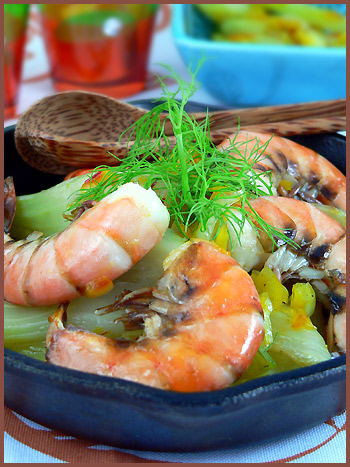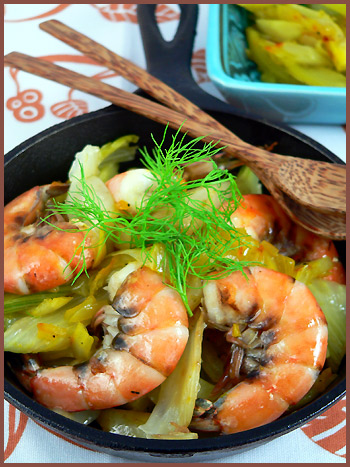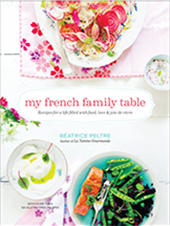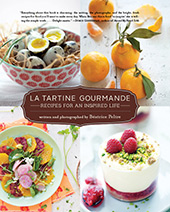
Come on, let’s go to Morocco!
We all know that cooking is not only the story of putting ingredients together. Beside the pleasure of creating and satisfying my langue gourmande (no translation needed, right?), I love to cook for another reason. You might think this is crazy but when I cook, I always let my mind wander according to what I am making. Hence if I am cooking exotic dishes, it almost (I said almost!) feels as if I could be in the country where the dish originates from, as I travel mentally to visit the place with its smells and colours. And so it comes to no surprise that I have a strong inclination for Moroccan cuisine. Because it is warm, colourful and full of delicate sweet spices. I should maybe confess that I own about 4 or 5 cookbooks about both Morrocan foods. 1 or 2 were not enough, I needed 5. Which I hardly even use, so go figure what kind of a problem I suffer from.
Moroccan food
– Why this love?
– The use of:
Saffron
And
Tajines
A typical tajine means stew and is a dish in which meat, fish or vegetables will be simmered for a long time over an open fire or a bed of charcoal, with various ingredients such as cinammon, olives, preserved lemons and spices of all kinds. It also refers to the recipient made of thick earthenware, with a pointed lid. My tajine recipient is a Le Creuset one which I use very often, for tajines per se but also any stews I want to cook in the oven. The typical meats cooked in tajines would be lamb, chicken, but the list of possibilities is long. As to the spices, you would find saffron, cumin, cinnamon, Ras el Hanout, coriander. Now in view of this tasteful list, how can one not be tempted to travel to Morocco? Impossible!
My dish is not going to be cooked in the oven, and does not require 2 hours cooking. So why call it tajine you wonder?
Well, think about this for a second. I am going to use fish, fennel, saffron and the dish can be cooked in the oven if you like. Also, if view of how the fennel is cooked, the result you have is melting-in-your-mouth vegetable. Does this not sound lovely? It might be well be that purists would say “mais non, ce n’est pas une tajine!” (It is not a tajine) but I simply had to find a fun name for my dish and am I not the princess in my own kitchen? Mais que si! (Of course I am ).
All in all, this is not the important matter anyway.
I have made this recipe many times and always try different kinds of fish; I have used shrimps, sole filets and haddock filets and I loved all 3. In other words, the kind of fish you choose is really pretty open to your fancy. Be creative and above all, make yourself pleased!
And by the way, you may notice that you can write tajine or tagine. For once I will not mess up the oral spelling of g versus j in English (’cause you see, in French, g is j and j is g...ok, I lost you already!)

(for 4 people)
You need:
- 2 large fennel bulbs
- 20 shrimps with shells, no heads (or fresh haddock fillets with skin or sole fillets)
- 3 shallots
- 1 saffron capsule
- Salt and pepper
- Olive oil
- 1 tsp sugar
Steps:
- Take a large tajine dish. Heat 1 to 2 Tbsp olive oil and when hot, cook the 3 shallots until softer (5 mns on medium to low heat).
- Add the thinly sliced fennel bulbs and cook for 1 mn while stirring.
- Add the saffron, salt and pepper and cover to simmer for 20 to 25 mns (or longer if you really like them very very soft).
- 5 mns before the end, add a dash of sugar.
- Remove the fennel from the tajine dish and heat another Tbsp olive oil.
- When hot, cook the shrimps for 2 mns on each side.
- Cover with the fennel confit. Serve hot.
I love to serve this dish with couscous.
Ingrédients :
- 2 grosses bulbes de fenouil
- 20 crevettes sans têtes (ou des filets de haddock avec la peau, ou des filets de sole)
- 3 échalotes
- 1 capsule de safran
- Sel et poivre
- Huile d’olive
- 1 càc de sucre
Étapes :
- Prenez un plat à tajine et faites-y chauffer l’huile d’olive. Cuisez les échalotes pendant quelques minutes, jusqu’à ce qu’elles soient translucides (feu moyen)
- Ajoutez ensuite les bulbes de fenouil coupées en longs sticks, et cuisez pendant 1 mn.
- Ajoutez le safran, du sel et du poivre et couvrez pour cuire pendant 20 à 25 mns (ou plus longtemps si vous les aimez super fondants comme moi).
- 5 mns avant la fin, ajoutez une pincée de sucre roux.
- Retirez le fenouil et mettez-le de côté.
- Faites chauffer une autre càs d ‘huile d’olive et quand elle est chaude, faites revenir les crevettes pendant 2 mn de chaque côté.
- Remettez le fenouil dans le plat à tajine et servez avec du couscous nature.



C’est un joli pont entre cuisine marocaine et cuisine asiatique que tu nous fait là. J’aime énormément le fenouil confit, ça doit être un vrai délice ce plat.
I totally relate to the fact that cooking international foods actually takes me to that country, that is the beauty of cooking! And Morocco is definitely the place to be right now. I love tagines, looks absolutely delicious, Bea!
very nice post, bea!
What a wonderful combination of flavors and ingredients. Thats what I like about exploring international dishes. I must try this soon!
Tu dis crevettes ou sole et pourquoi pas crevettes et soles 😉 Joli plat !
impossible de résister, je me laisse transporter
After three busy days where I did not get to sit and read my absolute favourite blog now I finally have the chance. Of course I must leave for work soon but this is ok.
Do you know that I have never had anything cooked in a tajine … doesn’t seem right!
But it sounds like you make these types of dishes so often and they sound so warm and inviting. I love that it’s just not for meat, but you can also make fish and seafood.
Lovely recipe. And the photo is beautiful.
Must get to Morocco one day!
Magnifiques couleurs & sublime recette !
One of the joys of traveling is eating the local cuisine, so it makes sense that when one is cooking that foreign places are evoked. Aroma’s especially have a way of triggering memories and imaginations.
Bravo Bea! It looks great!
I like exotic dishes … and Morocco and its flavours…. The coriander …
intraduisible ne français mais la grande question est on doit dire ‘une ” ou un tajine j’avoue que je n’ai toujours pas résolu le mystére et flemme le robert pour vérifier…
avec Framboise de Feuille de Chou, tu deviens une de mes favorites Béa, cette recette est encore une merveille, tu es douée 😉
hi bea, i’m sighing at the sheer beauty of those pictures – i can almost inhale the exotic, intoxicating scent of your lovely tagine from the screen 😉
Gracianne, oui tu as raison, et c’est si simple à faire!
Dianka, indeed. There was one time I was cooking tajines so often that P. would say:’ again!”
Kat, thanks!
David, thanks a lot. I hope you will like it!
Choupette, ah mais oui que sui-je bête! Tu as bien raison!
Anne, on voyage, n’est-ce pas?
Ivonne, oh you have to try them. They are really delicious. Imagine infused meats and fish with spices….
Merci Christelle!
Natalie, I fully agree. ALways love to know what people eat wherever I travel!
Gerald, merci!
Fabienne, ah yes Morocco is such a nice colourful place!
Astrid, moi je dirais une tajine, mon dico est en bas, je verifie! ;’-)
Lilo, ah merci, c’est super gentil ton message. Et toi ton blog me rappelle ma belle campagne. Et ca fait franchement plein de bien!
J, thanks! 😉 yes and this one is an easy one! I could feed msyefl everyday on the many tajines that exist!
Bea,
This looks fabulous. I can’t wait to try it and serve it at my next dinner party. The pictures are beautiful and the blog is absolutely lovely. I’ve enjoyed reading it.
Thanks,
Gourmandista
http://www.gourmandista.blogspot.com
Pingback: Cookthink: root source: shrimp